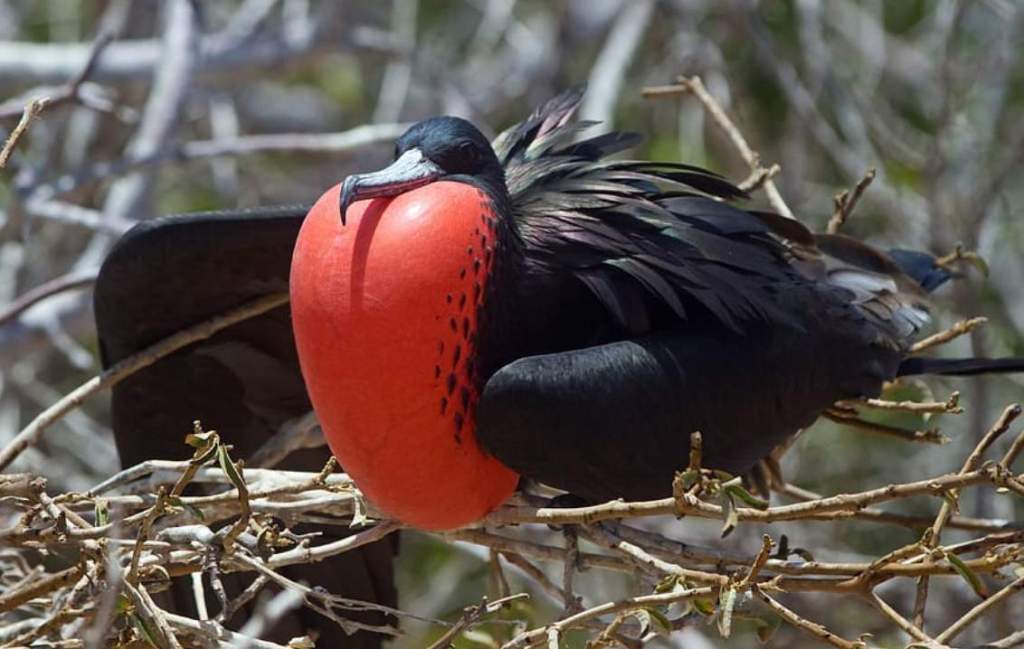Habitats: Great frigatebird (Fregata minor) neither walks nor swims, except accidentally, because it was adapted to live in the air. As its legs are short, it can only perch, and its toes aren’t fully webbed. By raising its huge wings, it takes off, and in flight, its body hangs low below the main plane of the wings like a gondola.
It is capable of outmaneuvering almost any other bird. Hovering, soaring, twisting, and gliding with apparent ease in updrafts and heat thermals along cliffs and forest edges is possible under its long, forked tail and broad, curving wings. There are times when small groups hang glide several hundred meters above the ground for hours at a time.
In cleared areas, frigatebirds are attracted to pools of rainwater and drink while skimming low over fresh or salt water. In order to air their flanks, they twist their wings upside down when sunbathing on land.
Their plumage, which is poorly oiled by a small preen gland, quickly becomes waterlogged if they land in the water. As piratical seabirds, frigatebirds steal food and nesting materials from other seabirds, mostly terns and boobies. Due to their nesting among the colonies of their victims, they are able to maintain this habit.
A frigatebird dives on a booby or tern flying back to its rookery with food in a spectacular swoop. The harasser quickly catches the incomer’s meal in midair after it disgorges. A frigatebird also steals eggs and unprotected chicks, eats carrion, and patrols beaches for hatchling turtles. Due to the time it takes their young to become independent, great frigatebirds nest every two years. The pairing is not permanent.
A small throat pouch of bare skin is inflated into a huge red balloon. This is done by males who take up their nest sites in clusters, spread their wings upwards, and inflate their wings. When a female flies over, they shiver and rattle their bills and quills violently to attract her. Throughout the ceremony, intermittent head waving and bilking are performed.
The Great frigatebird spends most of its life near its nesting islands, rather sedentary. Due to this, some Pacific islands hand-raise young frigatebirds and train them to feed on perches. Messages are carried between islands by such tame birds.

Feed: At sea, frigatebirds take flying fish and squid from the surface without landing; flying fish, caught in the long, hooked bills of frigatebirds, are often eaten in midair by underwater predators as they break the surface. As a result, frigatebirds follow the hunting shoals of tuna, the most prominent among these predators.
Wing span: The wingspan of a frigatebird is 205–230 cm. There is no bird with a larger ratio of wing area to body mass than the frigatebird and no bird with a lower wing loading than the frigatebird. Small differences between tropical air and water temperatures may enable the birds to take advantage of marine thermals.
Alternative Name: It is also known as the Greater frigatebird, the Man-of-War Bird, and Sea Hawk.
Size: The Great frigatebird’s size is about 850-980 long; however, the female is larger.
Identification: The male bird’s general plumage is uniformly black, with a light brown bar on the shoulder, and a red naked throat. The eyes are brown with a black eye ring. The bill is black. The feet are black or reddish brown in color. The female’s general plumage is black; the breast is white, grading to grey at the throat. Eyes brown with red eye-ring; naked throat blue. Bills blue-grey. The feet are pink to white. The immature bird’s general plumage is dark brown with light brown shoulder bars. The head and underparts are mainly white with varying amounts of rufous, yellow, and brown. The downy young are first naked, then grey-white downed; and bill and feet grey-white.

Vocalizations: Male on nest warbles wah-ho-ho-ho-ho and clappers a snore-like torrrr. When landing at the nest, the male makes a repetitive yelp tjew.-tjew-tjew, with individual variations.
Nesting & Breeding: Nesting and breeding take place from January to October. Tree and bush branches can accommodate a substantial platform made of sticks and vines. There are several thousand pairs of the species living in colonies. The nesting bushes are often shared with other species, especially red-footed boobies and frigatebirds. Both parents gather nest material, eggs are incubated in irregular shifts, and the naked hatchling is brooded for several weeks. The bird will be protected as soon as the down is covered. Despite the fact that young birds are fully feathered and fledged within four to five months, they still remain dependent on their parents for another two to six months until they are able to hunt on their own.
Eggs: Great frigatebird lays one glossy white egg; ellipsoidal, 68 x 48 mm.
Incubation: The incubation period is about 48-50 days, for both sexes. It takes four to five months for the young to fledged.
Distribution: The great frigatebird is found in most tropical seas of the world, including northeastern and northwestern Australia. Near Australia, it breeds only at the northern end of the Great Barrier Reef and in the Coral Sea.
Races: There are five races; two in Australia: one in the northwestern seas; the other breeding northeast in the Coral Sea.







